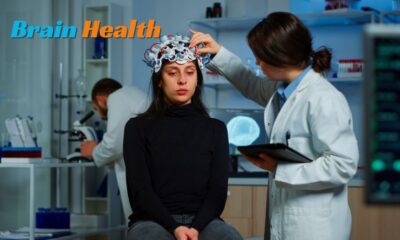Health
Blisterata: Understanding and Managing the Condition

Blisterata is a medical condition characterized by the formation of blisters on the skin, often accompanied by itching, pain, and inflammation. While it may seem like a simple skin issue, Blisterata can have significant impacts on a person’s quality of life. In this article, we delve into the causes, symptoms, treatments, and preventive measures associated with Blisterata.
Causes of Blisterata
Genetic Factors
Blisterata often has a genetic component, meaning it can run in families. Certain gene mutations predispose individuals to developing this condition.
Environmental Triggers
External factors such as exposure to allergens, irritants, extreme temperatures, or certain medications can trigger Blisterata flare-ups in susceptible individuals.
Symptoms and Diagnosis
Visible Signs
The hallmark symptom of Blisterata is the presence of fluid-filled blisters on the skin. These blisters may vary in size and can appear anywhere on the body.
Diagnostic Procedures
Diagnosing Blisterata typically involves a physical examination by a healthcare professional. In some cases, a skin biopsy or allergy testing may be necessary to confirm the diagnosis.
Treatment Options
Medications
Physicians may prescribe topical or oral medications to reduce inflammation, alleviate itching, and prevent blister formation. These may include corticosteroids, antihistamines, or immunosuppressants.
Therapies
Phototherapy, which involves exposing the skin to ultraviolet light, can help control Blis’teratasymptoms by suppressing inflammation and reducing blister formation.
Lifestyle Changes
Avoiding known triggers, maintaining good skin hygiene, and using gentle skincare products can help manage Blis’teratasymptoms and prevent flare-ups.
Preventive Measures
Avoiding Triggers
Identifying and avoiding triggers such as certain foods, allergens, or environmental factors can help reduce the frequency and severity of Blis’terataepisodes.
Healthy Lifestyle Practices
Maintaining a balanced diet, staying hydrated, getting regular exercise, and managing stress can support overall skin health and minimize Blisterata symptoms.
Research and Developments
Current Studies
Ongoing research efforts are focused on understanding the underlying mechanisms of Blis’terataand developing more targeted treatment approaches.
Future Prospects
Advancements in genetics, immunology, and dermatology hold promise for the development of novel therapies that could provide better outcomes for individuals with Blis’terata.
Living with Blisterata
Coping Strategies
Living with Blis’teratacan be challenging, but adopting coping strategies such as mindfulness techniques, seeking support from loved ones, and connecting with patient advocacy groups can help individuals manage the condition effectively.
Support Systems
Joining support groups or seeking counseling can provide emotional support and practical advice for navigating the physical and emotional challenges associated with Blis’terata.
Blisterata in Children
Unique Considerations
Children with Blis’teratamay require special attention and care to manage their condition effectively. Parents should work closely with healthcare providers to develop tailored treatment plans and support their child’s emotional well-being.
Parental Guidance
Educating children about their condition, teaching them proper skincare habits, and advocating for their needs in school and social settings are essential roles for parents of children with Blis’terata.
Conclusion
Blis’terata is a complex dermatological condition that requires comprehensive management strategies tailored to individual needs. By understanding its causes, symptoms, and treatment options, individuals can take proactive steps to minimize its impact on their daily lives and overall well-being.
FAQs
What are the common triggers of Blisterata?
Common triggers include certain foods, environmental allergens, stress, and hormonal changes.
Can Blisterata be cured completely?
While there is currently no cure for Blis’terata, treatment options can help manage symptoms and reduce flare-ups.
Is Blisterata hereditary?
Blisterata can have a genetic component, but environmental factors also play a significant role in its development.
How does weather affect Blisterata?
Extreme temperatures, humidity, and sun exposure can trigger or exacerbate Blis’terata symptoms in some individuals.
Are there any alternative therapies for Blisterata?
Some people find relief from Blis’terata symptoms through alternative therapies such as acupuncture, herbal remedies, or dietary supplements, but evidence supporting their effectiveness is limited.
Health
The Ultimate Guide to the 30 30 Workout

Are you looking for an efficient and effective way to get fit without spending hours at the gym? The 30 30 workout might be just what you need. In this article, we’ll dive deep into what the 30 30 workout is, its benefits, and how you can incorporate it into your fitness routine. Ready to transform your fitness game? Let’s get started!
What is the 30 30 Workout?
The 30 30 workout is a high-intensity interval training (HIIT) routine where you alternate between 30 seconds of intense exercise and 30 seconds of rest or low-intensity activity. This pattern is repeated for a set duration, typically ranging from 20 to 30 minutes.
Why Choose the 30 30 Workout?
Why should you opt for this workout? The 30 30 workout is designed to maximize your fitness gains in a short period. It’s perfect for those with busy schedules and offers numerous health benefits that we’ll explore later in this article.
History and Origin of the 30 30 Workout
The Evolution of Fitness Trends
Fitness trends have evolved significantly over the years, from traditional aerobics to modern HIIT programs. The 30 30 workout is part of this evolution, combining the best of cardiovascular and strength training into a compact, efficient routine.
Key Influences and Innovators
The 30 30 workout has been influenced by fitness experts and scientific research highlighting the benefits of interval training. Innovators like Dr. Izumi Tabata and other fitness pioneers have contributed to its development.
Benefits of the 30 30 Workout
Improved Cardiovascular Health
Interval training, like the 30 30 workout, has been shown to improve cardiovascular health by increasing heart rate variability and enhancing blood flow.
Enhanced Muscle Strength and Endurance
The mix of high-intensity and rest periods helps build muscle strength and endurance more effectively than steady-state cardio.
Increased Flexibility and Mobility
Incorporating different types of exercises can improve your flexibility and mobility, reducing the risk of injuries.
Time Efficiency
One of the biggest advantages is its time efficiency. You can achieve significant fitness gains in just 20-30 minutes a day.
How the 30 30 Work’out Works
Structure of a 30 30 Workout Session
A typical session involves alternating between 30 seconds of high-intensity exercise (like sprinting or burpees) and 30 seconds of rest or low-intensity activity (like walking or light jogging). This cycle is repeated multiple times.
Types of Exercises Included
The exercises can vary widely, from cardio moves like jumping jacks and mountain climbers to strength exercises like squats and push-ups.
Setting Up Your 30 30 Workout Routine
Assessing Your Fitness Level
Before starting, assess your current fitness level to choose appropriate exercises and intensity.
Choosing the Right Exercises
Select exercises that target different muscle groups and keep your routine balanced.
Creating a Balanced Routine
A well-rounded 30 30 workout includes a mix of cardio, strength, and flexibility exercises.
Warm-Up and Cool Down
Importance of Warming Up
Warming up prepares your body for intense activity, reducing the risk of injury.
Effective Warm-Up Exercises
Dynamic stretches and light cardio are great warm-up options.
Cooling Down for Recovery
Cooling down with static stretches helps your muscles recover and reduces soreness.
Sample 30 30 Work’out Plans
Beginner’s 30 30 Work’out Plan
Start with basic exercises like jumping jacks, bodyweight squats, and push-ups.
Intermediate 30 30 Work’out Plan
Add more challenging moves like burpees, mountain climbers, and lunges.
Advanced 30 30 Work’out Plan
Incorporate high-intensity exercises like sprinting, kettlebell swings, and plyometric jumps.
Common Mistakes to Avoid
Skipping Warm-Ups and Cool Downs
Never skip these essential parts of your workout.
Overdoing It
Avoid pushing yourself too hard, especially if you’re a beginner.
Not Staying Hydrated
Drink plenty of water before, during, and after your workout.
Tracking Progress and Staying Motivated
Using Fitness Apps and Wearables
Track your progress with fitness apps and wearables to stay motivated.
Setting Realistic Goals
Set achievable goals to keep yourself motivated and on track.
Rewarding Yourself
Celebrate your milestones with small rewards.
Nutrition and the 30’30 Work’out
Pre-Workout Nutrition
Eat a balanced meal with carbs and protein before your workout.
Post-Workout Nutrition
Refuel with protein and healthy carbs to aid recovery.
Hydration Tips
Stay hydrated by drinking water throughout the day.
Combining 30 30 Work’outs with Other Fitness Activities
Yoga and Pilates
Incorporate yoga or Pilates to improve flexibility and core strength.
Weight Training
Combine with weight training to build muscle mass.
Outdoor Activities
Enjoy outdoor activities like hiking or cycling for variety.
Adapting the 30 30 Work’out for Different Goals
Weight Loss
Focus on high-intensity cardio exercises to burn calories.
Muscle Gain
Include strength exercises to build muscle.
General Fitness
Mix different types of exercises for overall fitness.
The Science Behind the 30 30 Work’out
Interval Training and Its Benefits
Research shows that interval training improves cardiovascular health and burns more calories in less time.
Research Studies and Findings
Studies have found that HIIT workouts can be more effective than traditional cardio for weight loss and improving fitness.
Equipment Needed for the 30 30 Work’out
Essential Equipment
Basic equipment like a jump rope, dumbbells, or a resistance band can enhance your workout.
Optional Equipment for Advanced Routines
For advanced routines, consider adding kettlebells, medicine balls, or a weighted vest.
Conclusion
The 30 30 workout is an effective, time-efficient way to improve your fitness. Whether you’re a beginner or an advanced athlete, you can tailor this workout to meet your goals. Start incorporating the 30 30 workout into your routine and enjoy the benefits of better health and fitness.
FAQs
How often should I do the 30 30 work’out?
It’s recommended to do the 30 30 workout 3-4 times a week, allowing for rest days in between.
Can beginners try the 30 30 work’out?
Yes, beginners can start with lower intensity exercises and gradually increase the difficulty.
What if I miss a workout day?
Missing a day isn’t a big deal. Just get back on track the next day and continue your routine.
How do I prevent injuries?
Prevent injuries by warming up properly, using correct form, and not overexerting yourself.
Is the 30 30 work’out suitable for older adults?
Yes, with modifications for intensity and exercise selection, older adults can benefit from the 30 30’workout.
Health
Best Moisturizer for Combination Skin

Combination skin, characterized by having both oily and dry areas, can be tricky to manage. Finding the right moisturizer is essential for balancing hydration levels without exacerbating oiliness or dryness.
Understanding the Importance of Moisturizing
Moisturizing is crucial for all skin types, including combination skin. It helps maintain the skin’s moisture barrier, prevents water loss, and keeps the skin hydrated and healthy.
Factors to Consider When Choosing a Moisturizer for Combination Skin
Skin Type
Understanding your skin type is essential for selecting the right moisturizer. Combination skin requires a product that can hydrate dry areas without clogging pores or making oily areas greasier.
Ingredients
Look for moisturizers with lightweight, non-comedogenic ingredients that won’t clog pores or cause breakouts. Opt for products labeled “oil-free” or “water-based” to avoid exacerbating oiliness.
Texture
Choose a moisturizer with a lightweight, gel-like texture for oily areas and a richer, creamier formula for dry patches. This allows you to target specific areas of concern without overloading the skin.
Best Practices for Moisturizing Combination Skin
Cleansing Routine
Start with a gentle cleanser to remove dirt, oil, and impurities without stripping the skin’s natural oils. Follow up with a toner to balance the skin’s pH levels.
Exfoliation
Incorporate exfoliation into your skincare routine to remove dead skin cells and unclog pores. Choose a gentle exfoliator with alpha hydroxy acids (AHAs) or beta hydroxy acids (BHAs) to prevent irritation.
Sun Protection
Don’t forget to apply sunscreen daily, even if you have combination skin. Opt for a broad-spectrum SPF 30 or higher to protect against both UVA and UVB rays.
Top Ingredients to Look for in a Moisturizer for Combination Skin
Hyaluronic Acid
Hyaluronic acid is a hydrating powerhouse that attracts moisture to the skin’s surface, keeping it plump and hydrated without feeling heavy or greasy.
Niacinamide
Niacinamide, also known as vitamin B3, helps regulate oil production, minimize pores, and improve the skin’s barrier function, making it ideal for combination skin.
Glycerin
Glycerin is a humectant that draws moisture from the air into the skin, keeping it hydrated without clogging pores or causing breakouts.
Lightweight Oils
Opt for lightweight oils like jojoba oil or squalane that hydrate the skin without leaving a greasy residue. These oils mimic the skin’s natural sebum and help balance oil production.
Product Recommendations
Day Moisturizers
- Cetaphil Daily Facial Moisturizer
- Neutrogena Hydro Boost Water Gel
- La Roche-Posay Effaclar Mat Moisturizer
Night Creams
- CeraVe PM Facial Moisturizing Lotion
- The Ordinary Natural Moisturizing Factors + HA
- Clinique Moisture Surge Overnight Mask
Serums
- The Ordinary Hyaluronic Acid 2% + B5
- Paula’s Choice Niacinamide Booster
- Cosrx Advanced Snail 96 Mucin Power Essence
DIY Remedies for Combination Skin
- Aloe vera gel
- Green tea extract
- Honey masks
Common Mistakes to Avoid
- Overloading the skin with heavy, occlusive moisturizers
- Skipping sunscreen
- Using harsh, stripping cleansers
Conclusion
Finding the best moisturizer for combination skin requires understanding your skin’s unique needs and choosing products formulated to address them. By considering factors like skin type, ingredients, and texture, you can create a personalized skincare routine that keeps your skin balanced and hydrated without exacerbating oiliness or dryness.
FAQs
- Can combination skin benefit from using different moisturizers for oily and dry areas?
- Yes, using lightweight, gel-based moisturizers for oily areas and richer creams for dry patches can help balance hydration levels without clogging pores or causing breakouts.
- Is it necessary to moisturize combination skin if it already feels oily?
- Yes, moisturizing is essential for all skin types, including combination skin. Opt for lightweight, oil-free formulas to hydrate without adding excess oiliness.
- How often should I moisturize combination skin?
- Moisturize twice daily, in the morning and evening, after cleansing and toning your skin.
- Can I use serums in addition to moisturizers for combination skin?
- Yes, serums can be a beneficial addition to your skincare routine, especially those containing hydrating and balancing ingredients like hyaluronic acid and niacinamide.
- Are natural remedies effective for moisturizing combination skin?
- Some natural ingredients like aloe vera, green tea extract, and honey can provide hydration and soothe the skin, but results may vary depending on individual skin sensitivities and needs
Health
Brain Health: Nourishing Your Mind for Optimal Functioning

Our brains are remarkable organs that govern every aspect of our lives, from our thoughts and emotions to our physical movements and behaviors. Just like any other part of the body, the brain requires proper care and attention to function at its best. In this article, we will explore the various factors that contribute to brain health and provide practica tips for nourishing your mind for optimal functioning.
Importance of Brain’Health
Maintaining brain’health is essential for overall well-being and quality of life. A healthy’brain enables us to think clearly, make sound decisions, and navigate the complexities of daily life with ease.
Factors Influencing Brain’Health
Several factors influence brain health, including diet, exercise, mental stimulation, sleep, stress management, social interaction, and genetics. By addressing these factors, we can support and enhance brain function throughout our lives.
Nutrition and Brain’Health
Impact of Diet on Brain Function
The food we eat plays a crucial role in brain function. A balanced diet rich in essential nutrients such as omega-3 fatty acids, antioxidants, vitamins, and minerals supports cognitive function, memory, and mood regulation.
Foods That Promote Brain’Health
Incorporating foods like fatty fish, nuts, seeds, leafy greens, berries, and whole grains into your diet can nourish your brain and protect against cognitive decline.
Physical Exercise and Brain’Health
Connection Between Physical Activity and Brain’Health
Regular exercise not only benefits our physical health but also has profound effects on brain health. Exercise promotes neuroplasticity, enhances mood, reduces stress, and improves cognitive function.
Recommended Exercises for Brain’Health
Engaging in activities such as aerobic exercise, strength training, yoga, and tai chi can boost brain’health and support neurogenesis, the process of forming new brain cells.
Mental Stimulation and Brain’Health
Benefits of Mental Stimulation on Cognitive Function
Challenging your brain with mentally stimulating activities such as puzzles, games, reading, learning new skills, and socializing stimulates neural connections, improves memory, and enhances cognitive flexibility.
Activities to Enhance Brain Health
Incorporating activities that require problem-solving, creativity, and critical thinking into your daily routine can help maintain cognitive function and protect against age-related cognitive decline.
Quality Sleep and Brain’Health
Importance of Sleep for Brain Function
Sleep is essential for brain health, as it allows the brain to rest, repair, and consolidate memories. Chronic sleep deprivation can impair cognitive function, mood regulation, and overall well-being.
Tips for Improving Sleep Quality
Establishing a regular sleep schedule, creating a relaxing bedtime routine, minimizing screen time before bed, and creating a comfortable sleep environment can promote restful sleep and support brain health.
Stress Management and Brain’Health
Effects of Chronic Stress on the Brain
Chronic stress can have detrimental effects on brain health, leading to inflammation, impaired memory, and increased risk of mental health disorders such as anxiety and depression.
Techniques for Managing Stress Effectively
Practicing stress-reduction techniques such as mindfulness meditation, deep breathing exercises, progressive muscle relaxation, and spending time in nature can help alleviate stress and promote brain health.
Social Interaction and Brain Health
Impact of Social Connections on Brain Health
Maintaining social connections is vital for brain health, as it promotes emotional well-being, reduces the risk of cognitive decline, and enhances resilience to stress.
Ways to Foster Social Engagement for Brain Health
Participating in social activities, volunteering, joining clubs or organizations, and staying connected with friends and family members can foster meaningful relationships and support brain’health.
Brain Health Supplements
Overview of Supplements That Support Brain’Health
While a balanced diet is the best way to obtain essential nutrients for brain health, certain supplements may provide additional support. Omega-3 fatty acids, vitamin B12, vitamin D, and antioxidants are among the most commonly recommended supplements for brain’health.
Considerations When Choosing Supplements
Before taking any supplements, it’s essential to consult with a healthcare professional to ensure they are safe and appropriate for your individual needs. Quality, dosage, and potential interactions with medications should also be taken into consideration.
Brain’Health Across the Lifespan
Age-Related Changes in Brain’Health
As we age, our brains undergo natural changes that can affect cognitive function, memory, and overall brain’health. However, adopting healthy lifestyle habits can help mitigate age-related decline and promote lifelong brain’health.
Strategies for Maintaining Brain’Health at Different Life Stages
Implementing strategies such as staying mentally and physically active, eating a nutritious diet, managing stress, getting quality sleep, and staying socially engaged can support brain health at every stage of life.
Common Brain’Health Disorders
Overview of Prevalent Brain’Health Disorders
Brain’health disorders such as Alzheimer’s disease, Parkinson’s disease, stroke, depression, and anxiety can have significant impacts on cognitive function and overall quality of life.
Prevention and Management Strategies
While some brain’health disorders have genetic or environmental risk factors that are beyond our control, adopting a healthy lifestyle can help reduce the risk and manage symptoms. Early detection, medical treatment, and lifestyle interventions play crucial roles in prevention and management.
The Role of Genetics in Brain’Health
Genetic Factors Influencing Brain’Health
Genetics can influence susceptibility to certain brain’health disorders and cognitive abilities. Understanding genetic risk factors can help individuals make informed decisions about their health and take proactive steps to mitigate risks.
Ways to Mitigate Genetic Risks
While we can’t change our genetic makeup, we can modify lifestyle factors that interact with genetic predispositions. Healthy habits such as regular exercise, a balanced diet, mental stimulation, and stress management can help offset genetic risks and promote optimal brain health.
Brain’Health and Mental Well-being
Connection Between Brain Health and Mental Wellness
Brain’health and mental well-being are closely intertwined. Taking care of your brain through healthy lifestyle habits can improve mood, resilience, and overall mental health.
Holistic Approaches to Enhance Overall Well-being
In addition to addressing physical and cognitive aspects of brain’health, it’s essential to prioritize emotional and psychological well-being. Practices such as mindfulness, self-care, therapy, and seeking support from loved ones can foster holistic well-being.
Cultural Perspectives on Brain’Health
Cultural Beliefs and Practices Related to Brain’Health
Different cultures have unique beliefs and practices related to brain’health and wellness. Understanding cultural perspectives can help tailor interventions and support systems to meet diverse needs.
Integrating Cultural Values into Brain’Health Promotion
Incorporating cultural values, traditions, and community resources into brain’health promotion efforts can enhance engagement and effectiveness. Culturally sensitive approaches ensure that interventions are accessible, relevant, and respectful of diverse backgrounds.
Challenges in Maintaining Brain’Health
Barriers to Prioritizing Brain’Health
Despite the importance of brain’health, many individuals face barriers to prioritizing it in their lives. Busy lifestyles, lack of awareness, stigma surrounding mental health, and socioeconomic factors can hinder efforts to maintain optimal brain’health.
Overcoming Challenges for Optimal Brain’Health
Addressing barriers to brain’health requires a multifaceted approach that includes education, advocacy, policy changes, and community support. By raising awareness, reducing stigma, and promoting access to resources, we can empower individuals to prioritize brain’health and lead fulfilling lives.
Conclusion
In conclusion, prioritizing brain’health is essential for overall well-being and quality of life. By adopting healthy lifestyle habits, including nutrition, exercise, mental stimulation, sleep, stress management, and social engagement, we can nourish our minds and support optimal brain function at every stage of life. Remember, small changes can make a big difference in brain health, so start taking care of your brain today for a brighter tomorrow.
FAQs
What are the best foods for brain health?
Foods rich in omega-3 fatty acids, antioxidants, vitamins, and minerals, such as fatty fish, nuts, seeds, leafy greens, berries, and whole grains, are beneficial for brain health.
How does exercise benefit brain health?
Exercise promotes neuroplasticity, reduces inflammation, enhances mood, and improves cognitive function, supporting overall brain health.
Can supplements improve brain health?
While supplements may provide additional support for brain health, it’s essential to prioritize a balanced diet and consult with a healthcare professional before taking any supplements.
What role does genetics play in brain’health?
Genetics can influence susceptibility to certain brain health disorders and cognitive abilities, but lifestyle factors can help mitigate genetic risks and promote optimal brain health.
How can I prioritize brain health in my daily life?
Prioritizing brain’health involves adopting healthy lifestyle habits, including nutritious eating, regular exercise, mental stimulation, quality sleep, stress management, and social interaction.
-

 Health9 months ago
Health9 months agoBrain Health: Nourishing Your Mind for Optimal Functioning
-

 food8 months ago
food8 months agoBest Fast Food Protein: A Guide to Making Healthier Choices
-

 Health8 months ago
Health8 months agoThe Ultimate Guide to the 30 30 Workout
-

 management8 months ago
management8 months agoIntroduction to Project Valvrein
-

 food8 months ago
food8 months agoWhat to Eat: A Comprehensive Guide to a Balanced Diet Introduction
-

 food8 months ago
food8 months agoBest Takeout Food: Enjoy Delicious Meals in the Comfort of Your Home
